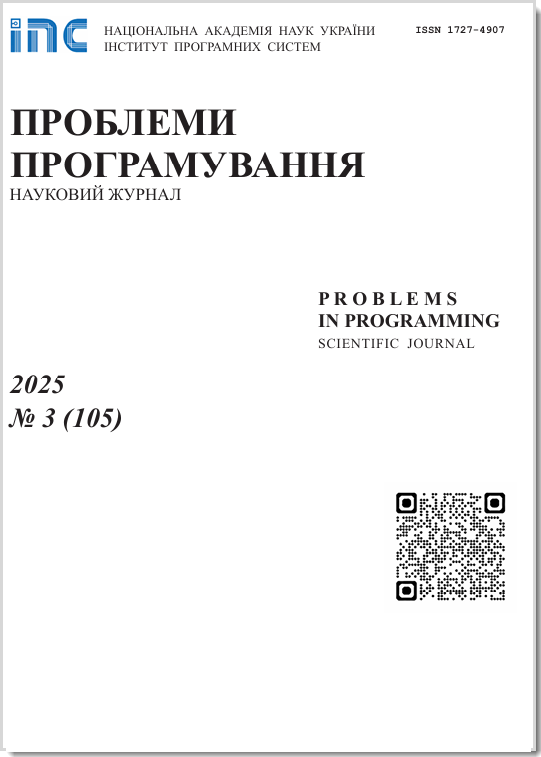Interface-oriented approach to modelling tools for multi-agent systems
Abstract
High-level modeling systems for multi-agent systems can significantly accelerate the process of developing and implementing software for autonomous multi-agent missions. Since different tasks require attention to specific aspects of modeling, an interface-oriented approach can be an effective means of adapting different models of the environment to given behavioral interfaces. Modeling of multi-agent systems covers a wide range of processes– from the physical movement of agents to the formation of behavioral strategies and the organization of their interaction. The interface-oriented approach makes it possible to create flexible multi agent modeling systems that can perform a wide range of tasks, ensuring the rapid development of behavioral models in a multi-agent environment and SITL testing of low-level autopilot code. As part of the approach, the design of the system begins with the definition of interface interaction between its components, which makes it possible to reuse the code and create individual implementations of components for specific experimental tasks. Work is underway on a prototype of the Blefusku multi-agent modeling system, one of the features of which is an interface-oriented approach and support for high-level behavioral description models. The main modules of the system are a modeling environment that contains a model of the environment and generates sensor signals, and an agent container that is responsible for the behavior of objects and the content of the communication environment. The interface is described as a gRPC service that allows connecting different components written in different programming environments. The communication layer is based on the MAVLink protocol. Behavior is determined by an object that is programmed to respond to sensor data and messages and periodic activities. A fragment of a search and rescue mission scenario with drones is given as an example.
Problems in programming 2025; 1: 110-117
Keywords
Full Text:
PDF (Українська)References
P. Andon, A. Doroshenko, V. Akylovsky, P. Ivanenko, O. Yatsenko, Formal and adaptive methods of constructing high performance parallel programs. Kyiv: Naukova Dumka, 2023. [in Ukrainian]
A. Doroshenko, O. Yatsenko, Formal and adaptive methods for automation of parallel programs construction: emerging research and opportunities. Hershey: IGI Global, 2021. CrossRef
Rahozin D. V., Doroshenko A. Yu. Modelling videocard memory performance for LLM neural networks, in: Problems in programming 2 3 (2024) 37-44. CrossRef
Doroshenko A. Yu., Okonsky I. V., Zhereb K. A., Beketov O. G. Using modeling tools to determine optimal parameters of program execution on video graphics accelerators, in: Problems in programming 2 (2013) 23-31. [in Ukrainian]
M. Quigley, B. Gerkey, K. Conley, J. Faust, T. Foote, J. Leibs, E. Berger, R. Wheeler, A. Y. Ng, ROS: an open-source Robot Operating System, in: Open-Source Software workshop of the International Conference on Robotics and Automation (ICRA) (2009) 1-6. Accessed: 04.03.2025. http://www.robotics.stanford.edu/~ang/papers/icraoss09-ROS.pdf
S. Macenski, T. Foote, B. Gerkey, C. Lalancette, W. Woodall, Robot Operating System 2: design, architecture, and uses in the wild, in: Science Robotics (2022) 7. CrossRef
ROS.Accessed: 04.03.2025. https://ros.org/
N. Koenig, A. Howard, Design and use paradigms for Gazebo, an open-source multirobot simulator, International in: 2004 IEEE/RSJ Conference on Intelligent Robots and Systems (IROS) (IEEE Cat. No.04CH37566) (2004), vol. 3, 2149-2154, CrossRef
Matlab ROS toolbox. Accessed: 04.03.2025. https://www.mathworks.com/products/ros.htm
S. Shah, D. Dey, C. Lovett, A. Kapoor, AirSim: high-fidelity visual and physical simulation for autonomous vehicles, in: ArXiv (2017) CrossRef
ros-sharp. Accessed: 04.03.2025. https://github.com/siemens/ros-sharp/
Unity-Robotics-Hub. Accessed: 04.03.2025. https://github.com/Unity-Technologies/UnityRobotics-Hub/
J. Arthur, V.-P. Berges, E. Teng, A. Cohen, J. Harper, C. Elion, C. Goy, Y. Gao, H. Henry, M. Mattar, D. Lange, in: arXiv preprint arXiv:1809.02627 (2020) doi: 10.48550/arXiv.1809.02627
CLOiSim: Multi-Robot Simulator. Accessed: 04.03.2025. https://github.com/lgeros2/cloisim
Y. Song, S. Naji, E. Kaufmann, A. Loquercio, D. Scaramuzza, Flightmare: a flexible quadrotor simulator, in: Conference on Robot Learning (CoRL) (2020) 1-11. Accessed: 04.03.2025. https://rpg.ifi.uzh.ch/docs/CoRL20_Yunlong.pdf
M. Fernandez-Cortizas, M. Molina, P. Arias Perez, R. Perez-Segui, D. Perez-Saura, P. Campoy, Aerostack2: a software framework for developing multi-robot aerial systems, in: ArXiv (2023). doi: 10.48550/arXiv.2303.18237
F. L. Bellifemine, G. Caire, D. Greenwood, Developing multi-agent systems with JADE (Wiley Series in Agent Technology), John Wiley & Sons, 2007. CrossRef
Jade. Accessed: https://jade.tilab.com/
P. Pierpaoli, T. T. Doan, J. Romberg, M. Egerstedt, Sequencing of multi-robot behaviors using reinforcement learning, in: Control Theory and Technology 19 (2021) 529-537. CrossRef
C. Street, B. Lacerda, M. Staniaszek, M. Mühlig, N. Hawes, Context aware modelling for multi-robot systems under uncertainty, in: 21st International Conference on Autonomous Agents and Multiagent Systems (AAMAS'22). International Foundation for Autonomous Agents and Multiagent Systems (2022) 1228-1236. Accessed: 04.03.2025. https://www.ifaamas.org/Proceedings/aamas2022/pdfs/p1228.pdf
DOI: https://doi.org/10.15407/pp2025.01.110
Refbacks
- There are currently no refbacks.




